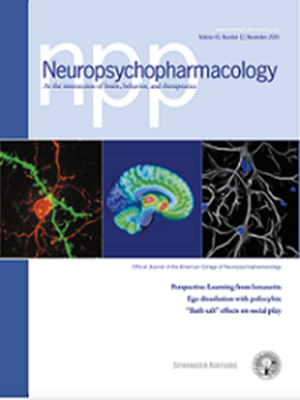Abnormal ventromedial-to-dorsolateral hierarchical topography of striatal circuits in cocaine use disorder and its modulations by brain stimulation
IF 6.6
1区 医学
Q1 NEUROSCIENCES
引用次数: 0
Abstract
Cocaine use disorder (CUD) has been linked to cortico-striatal dysfunctions, particularly within the prefrontal-striatal circuitry. However, previous studies have typically focused on discrete parcellations of the striatum, overlooking its continuous variations of neural organization. Moreover, while repetitive transcranial magnetic stimulation (rTMS) has shown benefits in CUD treatment, the neural effects of rTMS on striatal dysfunction in CUD remain poorly understood. Using connectome gradient-mapping techniques on three resting-state functional magnetic resonance imaging datasets, we derived the ventromedial-to-dorsolateral striatal functional topography. We identified specific alterations in this topography in the discovery cohort (41 CUD patients and 44 controls), validated findings in an independent cohort (53 CUD patients and 45 controls), and examined whether rTMS targeting the left dorsolateral prefrontal cortex (dlPFC) could normalize abnormalities in the rTMS-treatment cohort (44 patients). Across all datasets, we found a positive correlation between gradient variation and drug dependence severity in CUD. Compared to controls, CUD in both the discovery and replication cohorts exhibited elevated gradient values in the ventral striatum, while decreased values in the dorsal striatum were observed only in the discovery cohort. Furthermore, in the rTMS-treatment cohort, 5-Hz rTMS targeting the left dlPFC significantly normalized the aberrant gradient values in the ventral striatum, and these changes also related to cocaine craving changes. Overall, our study provides novel evidence of specific alterations in the ventromedial-to-dorsolateral functional topography of the striatum in CUD patients and highlights the impact of rTMS on striatal circuits through prefrontal modulation.

可卡因使用障碍患者纹状体回路的腹内侧至背外侧分层结构异常及其脑刺激的调节作用。
可卡因使用障碍(CUD)与皮质纹状体功能障碍有关,尤其是在前额叶-纹状体回路中。然而,以往的研究通常侧重于纹状体的离散部分,忽略了其神经组织的连续变化。此外,虽然重复经颅磁刺激(rTMS)已显示出对 CUD 治疗的益处,但人们对 rTMS 对 CUD 纹状体功能障碍的神经影响仍然知之甚少。我们在三个静息态功能磁共振成像数据集上使用了连接组梯度映射技术,得出了从腹内侧到背外侧的纹状体功能地形图。我们在发现队列(41 名 CUD 患者和 44 名对照组)中确定了该地形图的特定改变,在独立队列(53 名 CUD 患者和 45 名对照组)中验证了研究结果,并研究了针对左侧背外侧前额叶皮层 (dlPFC) 的经颅磁刺激是否能使经颅磁刺激治疗队列(44 名患者)中的异常恢复正常。在所有数据集中,我们发现梯度变化与 CUD 的药物依赖严重程度呈正相关。与对照组相比,发现组和复制组中的 CUD 腹侧纹状体梯度值升高,而仅在发现组中观察到背侧纹状体梯度值降低。此外,在经颅磁刺激治疗队列中,以左侧大脑下丘脑为靶点的 5 赫兹经颅磁刺激能显著使腹侧纹状体的异常梯度值恢复正常,这些变化也与可卡因渴求的变化有关。总之,我们的研究为CUD患者纹状体腹内侧到背外侧功能拓扑的特定改变提供了新的证据,并强调了经颅磁刺激通过前额叶调节对纹状体回路的影响。
本文章由计算机程序翻译,如有差异,请以英文原文为准。
求助全文
约1分钟内获得全文
求助全文
来源期刊

Neuropsychopharmacology
医学-精神病学
CiteScore
15.00
自引率
2.60%
发文量
240
审稿时长
2 months
期刊介绍:
Neuropsychopharmacology is a reputable international scientific journal that serves as the official publication of the American College of Neuropsychopharmacology (ACNP). The journal's primary focus is on research that enhances our knowledge of the brain and behavior, with a particular emphasis on the molecular, cellular, physiological, and psychological aspects of substances that affect the central nervous system (CNS). It also aims to identify new molecular targets for the development of future drugs.
The journal prioritizes original research reports, but it also welcomes mini-reviews and perspectives, which are often solicited by the editorial office. These types of articles provide valuable insights and syntheses of current research trends and future directions in the field of neuroscience and pharmacology.
 求助内容:
求助内容: 应助结果提醒方式:
应助结果提醒方式:


